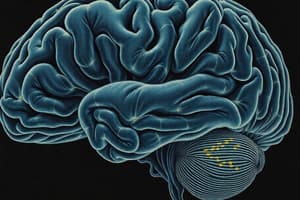Podcast
Questions and Answers
Which structure is not primarily associated with gray matter?
Which structure is not primarily associated with gray matter?
- Nuclei in the brain
- Cortex of cerebrum
- Horns of spinal cord
- Corpus callosum (correct)
Which of the following correctly identifies a function of the hypothalamus?
Which of the following correctly identifies a function of the hypothalamus?
- Regulates auditory stimuli
- Interprets visual stimuli
- Processes sensory information from the skin
- Controls ANS and regulates body temperature (correct)
What type of brain waves are associated with Stage 4 non-REM sleep?
What type of brain waves are associated with Stage 4 non-REM sleep?
- Irregular waves
- Alpha waves
- Delta waves (correct)
- Theta waves
Which brain structure is primarily involved in muscle memory?
Which brain structure is primarily involved in muscle memory?
Which part of the brain is involved in balance and equilibrium?
Which part of the brain is involved in balance and equilibrium?
The term 'corpus striatum' refers to which combination of structures?
The term 'corpus striatum' refers to which combination of structures?
What area of the brain is primarily responsible for the perception of taste?
What area of the brain is primarily responsible for the perception of taste?
Which structure plays a key role in the sleep-wake cycle through melatonin production?
Which structure plays a key role in the sleep-wake cycle through melatonin production?
Which component is NOT part of the limbic system?
Which component is NOT part of the limbic system?
Flashcards
Gray Matter
Gray Matter
The outer layer of the brain, primarily responsible for higher-level functions like thinking, memory, and language.
White Matter
White Matter
The inner layer of the brain, primarily composed of myelinated nerve fibers, facilitating communication between different brain regions.
Basal Nuclei
Basal Nuclei
Clusters of neurons involved in planning and coordinating voluntary movements.
Thalamus
Thalamus
Signup and view all the flashcards
Hypothalamus
Hypothalamus
Signup and view all the flashcards
Midbrain
Midbrain
Signup and view all the flashcards
Medulla Oblongata
Medulla Oblongata
Signup and view all the flashcards
Cerebellum
Cerebellum
Signup and view all the flashcards
Reticular Formation
Reticular Formation
Signup and view all the flashcards
Limbic System
Limbic System
Signup and view all the flashcards
Study Notes
Gray and White Matter Locations
- Gray matter is found in horns, nuclei within the brain, and the outer cortex of the cerebrum and cerebellum.
- White matter is located in columns, beneath the cortex, and includes the corpus callosum.
Basal Nuclei
- Structures: Caudate nucleus, putamen, globus pallidus.
- Lentiform nucleus is composed of the globus pallidus and putamen.
- Corpus striatum includes the caudate nucleus and lentiform nucleus.
- Function: Involved in semivoluntary movements like arm swinging during walking.
Sleep Stages and Brain Waves
- Stage 1 NREM: Alpha waves.
- Stage 2 NREM: Irregular brain waves.
- Stage 3 NREM: Theta and delta waves.
- Stage 4 NREM: Primarily delta waves.
- REM: Characterized by skeletal muscle paralysis.
Cerebrum Lobes and Functions
- Gustatory Cortex: Insula, responsible for taste perception.
- Olfactory Cortex: Temporal and frontal lobes, involved in smell perception.
- Primary Auditory Cortex: Temporal lobe, processes sound (volume and pitch).
- Primary Somatosensory Cortex: Postcentral gyrus, detects touch, temperature, and spatial awareness.
- Primary Visual Cortex: Occipital lobe, involved in interpreting light, color, shape, and movement.
- Vestibular Cortex: Insula, related to balance and equilibrium.
- Visceral Sensory Area: Insula, senses from internal organs.
- Auditory Association Area: Temporal lobes, interprets sounds.
- Somatosensory Association Area: Postcentral gyrus, interprets touch and textures.
- Visual Association Area: Occipital lobe, interprets visual stimuli.
- Premotor Cortex: Frontal lobe, involved in muscle memory.
- Primary Motor Cortex: Precentral gyrus, controls voluntary movements.
- Broca's Area: Left frontal lobe, speech (muscle movements).
- Wernicke's Area: Parietal and temporal lobes (left), processes visual and auditory stimuli.
- Prefrontal Cortex: Frontal lobe, higher-level thinking.
Diencephalon
- Epithalamus: Houses the pineal body, regulating melatonin production (important for sleep-wake cycles and seasonal affective disorder).
- Thalamus: Plays a key role in sensory relay, with the intermediate mass being a central feature.
- Hypothalamus: Controls the autonomic nervous system, influences the limbic system and endocrine system, and also plays a significant role in regulating behaviors like eating, drinking, temperature regulation, and monitoring the circadian rhythm.
- Mammillary Bodies: Involved in memory.
Brainstem
- Midbrain (Mesencephalon):
- Cerebral peduncles: important pathways.
- Superior colliculi: visual reflexes.
- Inferior colliculi: auditory reflexes.
- Substantia nigra: Crucial for dopamine production, plays a role in movement disorders.
- Red nucleus: involved in motor control.
- Pons: Contains centers for salivation and respiration.
- Medulla Oblongata: Contains crucial centers for cardiovascular, respiratory, swallowing, and emetic (vomiting) functions.
- Decussation (crossing over) occurs in the medulla.
Cerebellum
- Coordination of movement.
Brain Ventricles
- Fluid-filled spaces within the brain.
Functional Systems
- Reticular Formation: Maintaining consciousness.
- Limbic System: Regulates emotions, memory, and motivation.
- Included structures include amygdala, cingulate gyrus, fornix, and hippocampus.
Studying That Suits You
Use AI to generate personalized quizzes and flashcards to suit your learning preferences.




